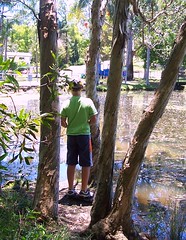
E-Learning is electronicly-based training, that can be CD-ROM based, network based, Intranet or Internet based, which could include text, video, audio, animation, powerpoint and slideshare with new software and programs becoming available every minute. It is a hands on self-paced learning tool that can be implemented into the classroom for effective engaged teaching. These effective Learning tools can be utilised throughout the Curriculum in all KLA's (2007)along with the in school Frameworks which go along with many theorists.
The purpose of this Blog is to map out the advantages of implementing them within all Curriculum areas in the classroom whilst still meeting criteria that is set out with the Queensland Studies Authority and Queensland Education.
Many theorists like Kearsley and Shneiderman (1998), Oliver (1999) and Prensky (2005) all agree that in using the Engagement Theory which is a conceptual framework for technology based learning and teaching through interactive meaningful and relevant activities that are linked to the real word will facilitate engagement. Whether they are Digital Natives or Digital immigrants (Prensky 2001).
The many and varied topics of technologies that have been researched and some tested within the classroom, throughout this Blog will inform you on how they can be implemented in the classroom regardless of subject, age, year level, cultural background, learning ability and even limited accessability to some technologies. However, most but not all of these technologies do require access to the internet.
In using a Blog to reflect and demonstrate my learning and research of these technologies has enhanced my understanding and knowledge whilst using my critical thinking skills and creative skills. I have been encouraged to think about my thinking whilst practicing higher order thinking in my ideas and lesson activities to ensure my students will be engaged throughout a lesson that is presented when using these applications, like; Will my students be able to distinguish between ......, Will they be confident in trying self-directed learning after ....... and so on.
Throughout the varied technologies I have indicated that by utilising some or most of these technologies you can create a virtual classroom, that will faciliate engagement throughout the lessons and enable the students to fulfill the curriculum requirements whilst developing their Literacy and thinking skills, becoming analytical, critical and creative thinkers (Marzano, 1997) and building their confidence and self-esteem. All of this builds to a confident happy student who will envelope learning and knowledge building.
I have also indicated in some of the applications how the Essential Learnings(QSA,2007), Learning Designs and Problem based Learning Methodologies (CQU, 2002) are incorporated into each lesson. I have also commented and noted on other students Blogs regarding some of their ideas and suggestions.
I found Kerri Norman's http://kerris-elearningjourney.blogspot.com/ suggestions on Blogs in the Classroom very interesting, she suggests; the use of avatars, along with uploaded videos, handouts and quizzes that could be all to one task along with homework tasks to be completed. Kellie Stephens http://kells-expedition.blogspot.com/ also had some great ideas and suggestions on using Powerpoint Buttons and quizzes. She suggested to import a quiz into a powerpoint and and have the quiz at the end of a powerpoint that holds all required information. I will have to try that one.
I had no idea the amount of programs and free ones that are out there in cyber world. Discovering the many engaging and interactive uses these applications can play in the classroom for a more effective teaching approach is mind boggling. I originally thought that it would be limited to what you could do in the classroom with some of these applications but my eyes have been opened and my mind is beginning to tick. I have no doubt that using a lot more technology within the curriculum will definately engage and encourage higher learning and enthusiasm towards learning in the classroom. Particulary the remote Indigenous communities, this approach to learning and teaching will bring a renewed energy to the classroom and attendance as long as they are related to real world activities and also to themselves. These kids do not have a big opportunity to engage and experiment with these types of tools, so implementing them into the classrooms will invigorate their attitiude in the right direction.
I am looking forward to using and testing a lot of these ideas and technologies in the classroom, I have enjoyed my time researching and learning about these not so new technologies although sometimes may have been frustrating and I have ended up yelling at the computer, I have a new attitude towards technology and it's uses. Wouldn't it be great to have a wiki that is dedicated to different uses and lesson plan ideas for these technologies that could be shared, hmmm just might set my Wiki up for that.
Thanks Wendy.
References;
Central Queensland University. (2002). Problem-based Learning. Retrieved on August 17, from http://pbl.cqu.edu.au/
Kearsley, G & Shneiderman, B. (1998). Engagement Theory. Retrieved August 20, from, http://home.sprynet.com/~gkearsley/engage.htm
Marzano,R., Pickering, D., Arredondo,D., Blackburn, G., Brandt, R., Moffett, C., Paynter, D., Pollock, J. & Whisler, J. (1997). Dimensions of Learning, teacher's Manual. Colorada. McREL.
Oliver, R. (1999). Exploring strategies for on-line teaching and learning. Distance Education, 20(2), 240-254.
Prensky, M. (2005). Engage Me or Enrage Me - What today's learners demand. Retrieved August 20, from,http://net.educause.edu/ir/library/pdf/erm0553.pdf
Prensky, M. (2001). Digital Natives, Digital Immigrants. Retrieved August 20, from, www.marcprensky.com/writing/Prensky%20-%20Digital%20Natives,%20Digital%20Immigrants%
Queensland Studies Authoriy (QSA), Queensdland Curriculum, Assessment and Reporting Framework (2007), Essential Learnings. Retrieved August 20, from http://www.qsa.qld.edu.au/learning/7284.html




